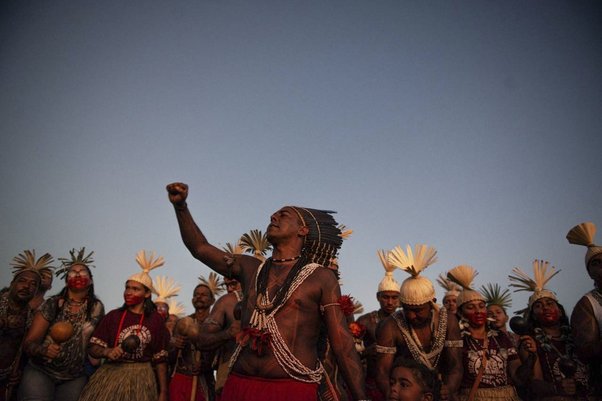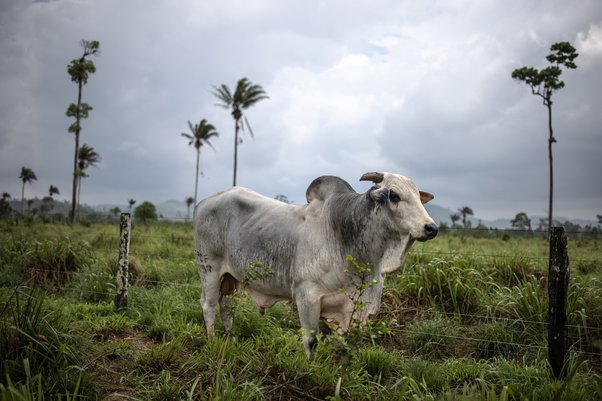COP16 – or the biodiversity COP – took place over the last two weeks in Cali, Colombia, where world leaders, government representatives, civil society, land and environmental defenders, activists and Indigenous and Afro-descendant groups gathered to discuss the urgent crisis of biodiversity loss.
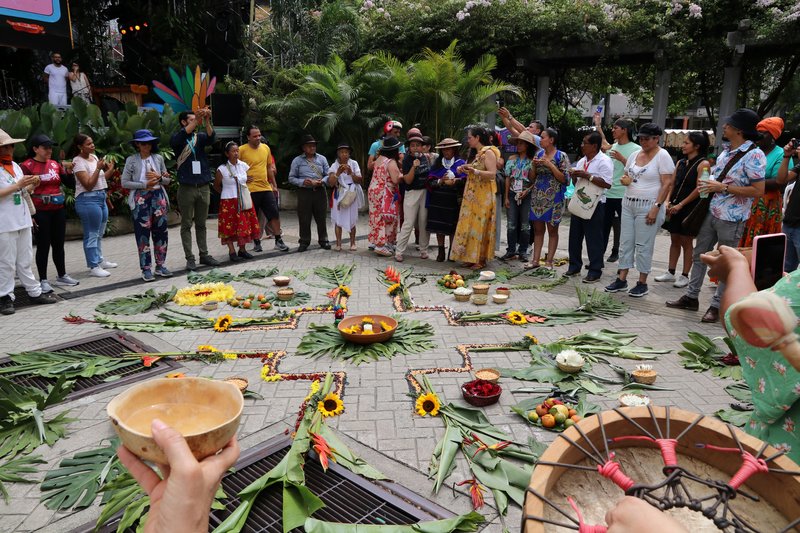
Members of the public participate in a ceremony to honour the natural world in the “green zone” of COP16. Molly Robson / Global Witness
It was an opportunity for the international community to assess global and national progress against the Kunming-Montreal Global Biodiversity Framework (KMGBF) – a set of targets and goals adopted at COP15 which, if realised, could help humanity live in harmony with nature by 2050.
Nestled within the dramatic backdrop of Cali’s mountains and under the stifling tropical heat, the conference was rife with contradictions.
Leaders of the world’s biggest corporations sat on panels with some of the world’s most formidable activists. Moving stories of human resistance contrasted with dry policy talks. Bold calls to action were underwhelmed by weak pledges and glacial decision-making. Moments of inspiration were offset by painful reminders of the critical situation the planet is in.

Dusk in the restricted “blue zone" of COP16. Molly Robson / Global Witness
Speaking at the same time as the conference’s opening, scientists and academics underscored this urgency: humanity, one warned, is “shattering Earth’s natural limits.”
A recent study revealed that nature’s carbon sinks are beginning to fail – a stark sign of breakdowns across essential ecological processes.
"We are beginning the era of human extinction. I do not think I am exaggerating," Colombian President Gustavo Petro said at the opening of Tuesday's COP16 meeting with six presidents and more than 100 government ministers.
"Nature is life. And yet we are waging war against it. A war where there can be no winner," said UN Secretary-General Antonio Guterres. "This is what an existential crisis looks like."
And as nature faces this existential crisis, so do those who defend it. The conference was held in the deadliest country for land and environmental defenders, where attacks surged to record levels in 2023.
Journalists and defenders that we spoke with described how, in Colombia, standing up for the environment means living under a constant threat of death.
Indeed, it feels hard to imagine a higher-stakes situation.
Here are the key themes and takeaways from the conference.
Indigenous communities have the solutions – the path forward must be centred on them
A driving theme in both policy sessions and deeper conversations was the recognition that humanity has drifted from its fundamental connection with nature.
This disconnection is no accident – it’s an ideological trait of colonialism, which for centuries has systematically erased Indigenous knowledge, culture and lands.
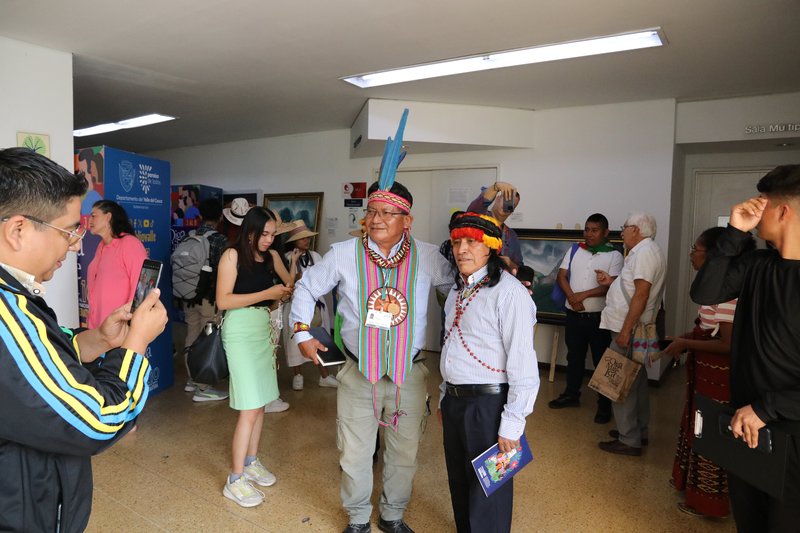
Indigenous leaders pose for a photo following a Global Witness talk about creating a safer environment for land and environmental defenders. Molly Robson / Global Witness
Much lip service has been paid to traditional knowledge at these summits, but to date, Indigenous communities remain painfully underrepresented in the high-level negotiations that determine the final shape of state commitments to protect nature.
Even worse, some are actively silenced. On Wednesday 30 October, Brazilian Indigenous activist Txai Suruí led a peaceful protest within the restricted "blue zone" of the summit to oppose the Marco Temporal – a legal mechanism aimed at stripping back Indigenous rights over their own lands and enabling exploitation of the natural resources they protect.
Despite voluntarily ceasing their demonstration, Txai and her group were forcibly detained for their peaceful protest, and at one point, the Indigenous leader reportedly had her badge temporarily removed.
If this is the level of repression taking place at the world’s most famous biodiversity summit, one can only imagine what might be happening when the world isn’t watching.
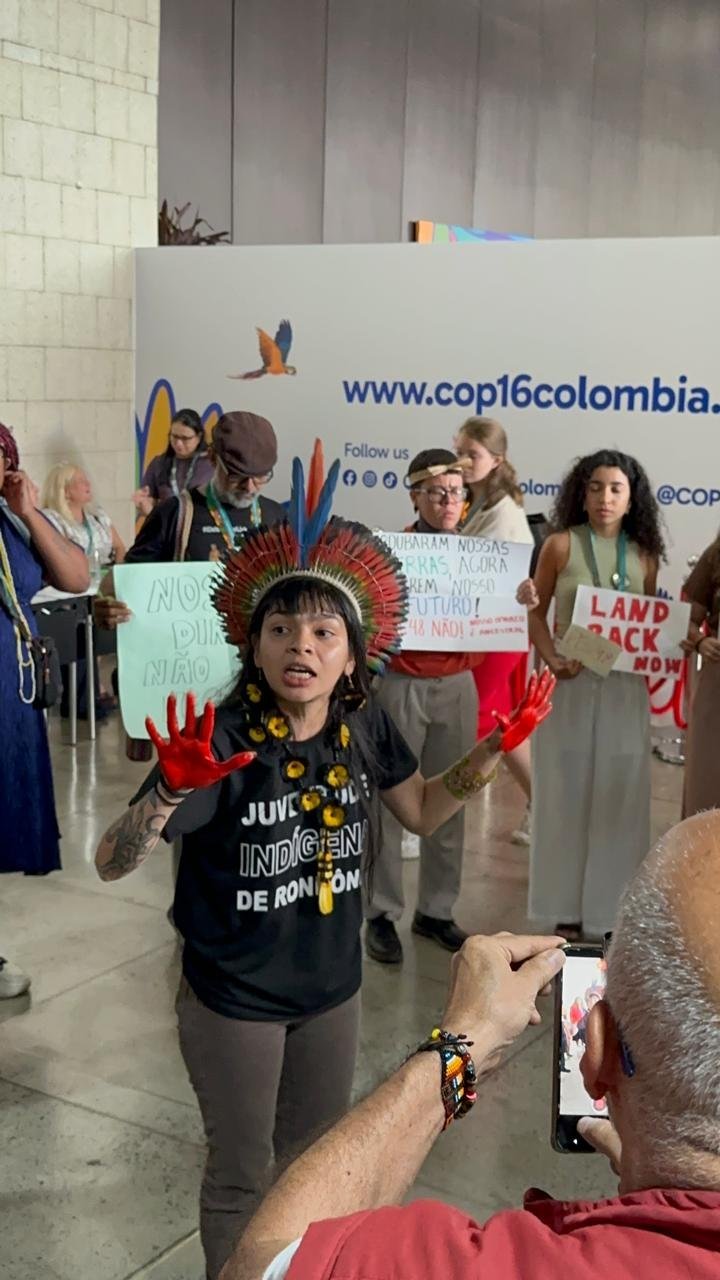
Brazilian Indigenous activist Txai Suruí led a peaceful protest within the restricted "blue zone". Txai Suruí / Global Witness
At one Global Witness panel, Alexandra Narváez, an Indigenous leader from Ecuador’s community, echoed frustrations over the exclusion of Indigenous peoples and defenders from COP16’s closed-door negotiations also held in the blue zone.
“It’s good to see other Indigenous Peoples here, [at the conference]” Narváez said. “We are on the frontlines, defending the territory. But [governments and states] are negotiating on our behalf – without us. We are tired of their lies. We are tired of asking.”
But hope broke through at the close of negotiations with a milestone agreement: Indigenous Peoples and local communities were granted a "permanent role" in biodiversity decision-making through the establishment of a dedicated body within the UN biodiversity process.
Described as a historic breakthrough, this decision allows Indigenous representatives to participate directly in negotiations, bypassing the unreliable goodwill of governments. Delegates also committed to a formal role for Afro-descendant communities within this new subsidiary body.
Cheers and tears allegedly erupted across the room as the agreement was announced: marking a long overdue first step in ensuring that Indigenous Peoples and Afro-descendant communities have a guaranteed voice in decisions impacting their lands and communities.
To have “peace with nature", violence against environmental defenders must end
Another heavy subject at COP16 was securing better protections and meaningful participation in policy negotiations for land and environmental defenders.
Central to these discussions was Target 22 of the KMGBF, which aims to establish international policies to safeguard defenders from violence and harassment.
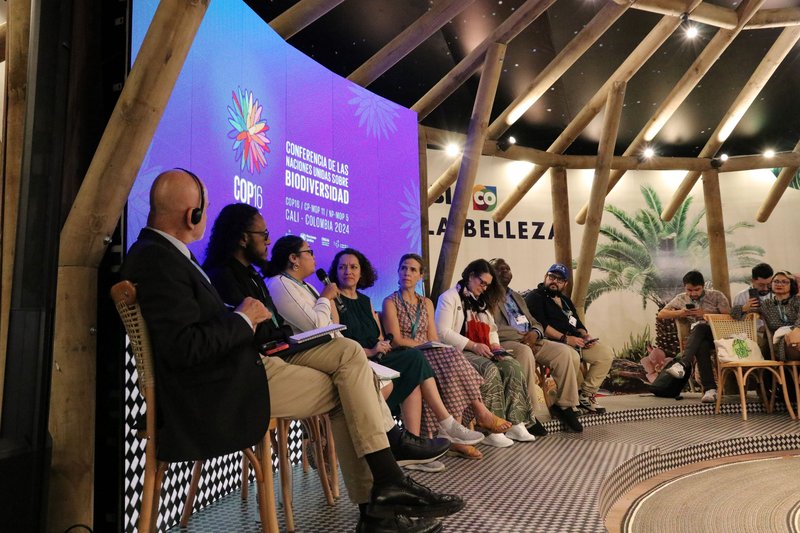
Panellists speak about the importance of data in tracking attacks against land and environmental defenders. Molly Robson / Global Witness
In Colombia alone, 79 defenders were killed last year, with Latin America accounting for 85% of all defender killings in 2023. These figures are almost certainly an underestimate.
Year on year, governments across the world have failed to meaningfully protect defenders or secure their material safety.
Throughout COP16, Global Witness hosted events ranging from high-level policy panels to participatory dialogue and workshops, where defenders shared firsthand the consequences of their activism.
Defenders recounted targeted assassinations of family and community members, the illegal destruction of their rightful territories, and the exhausting burden of fighting for their basic rights in a system that grants corporations and financial institutions impunity.
In most cases, actors responsible for environmental destruction and its associated violence not only go unpunished – they often continue to profit, sometimes to the tune of billions.
And as those on the frontlines struggle to retain protection of the world’s remaining biomes, defenders spoke about how threats against them are becoming increasingly sophisticated and coordinated.
At our event about creating a safer environment for land and environmental defenders, Aryampa Brighton, a Ugandan lawyer and activist working against the controversial East African Crude Oil Pipeline (EACOP), described how governments and corporations are colluding to suppress community resistance.
He told us how financial coercion and social repression are becoming common, with governments weaponising deceptive compensation schemes to clear residents from their homes.
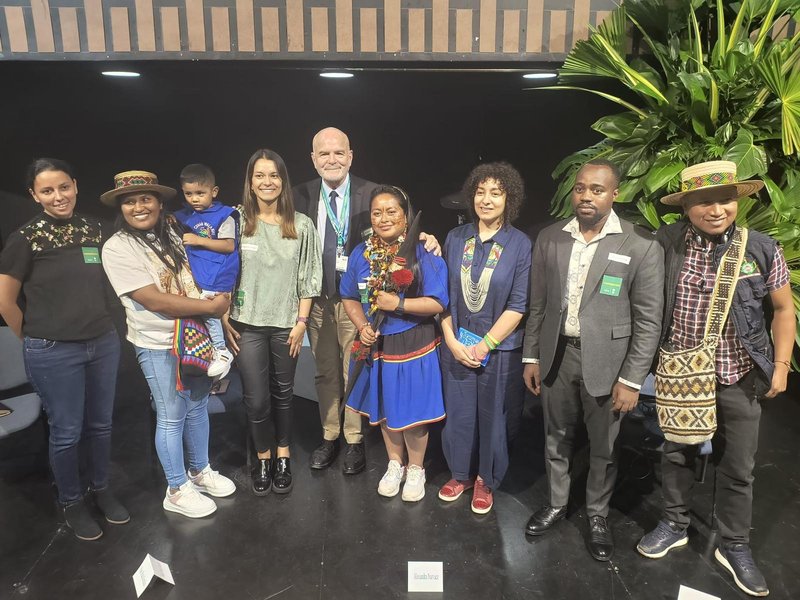
Defenders pose for a photo after participating in a panel event on how to ensure better protection and participation for guardians of biodiversity. Javier Garate / Global Witness
“When you take away someone’s land, you take away their livelihood,” Brighton said. “For me, stopping EACOP is not just a Ugandan fight but a global fight, because of the far-reaching impacts of the project.”
While direct violence is the most visible consequence of speaking out as an environmental defender, the scars also run much deeper.
Some defenders spoke about how violence is not always individual and direct, but systemic, historic, gendered and racialised – something that seeps into the social fabric of entire communities.
In a panel organised with Colombian congressman Juan Carlos Losada and Amazon Watch, Indigenous activist and congresswoman Célia Xakriabá spoke on the emotional and psychological toll endured in the fight for Indigenous and environmental rights.
Colonial trauma and environmental abuse often go hand in hand – as underscored by the corrosive legacy of Brazil’s Bolsonaro-era policies that aggressively dismantled Indigenous rights alongside environmental ones.

Célia Xakriabá speaks at a Global Witness event on the acute dangers faced by communities and individuals standing up to extractive development. Molly Robson / Global Witness
“Hunger kills, suicide kills,” Xakriabá said of the community impacts of such hostile governance. “And working in politics, we have to face our killers.”
During our screening of the film We Are Guardians, Brazilian defenders Claudelice Silva dos Santos and Tye Parakanã also gave testimonies about the horrors their communities endure from deforestation, driven by unchecked corporate and financial interests in the Amazon.
Deforestation, they explained, isn’t just an environmental issue – it is deeply tied to human rights abuses, displacement and violence against Indigenous communities who stand in its way.
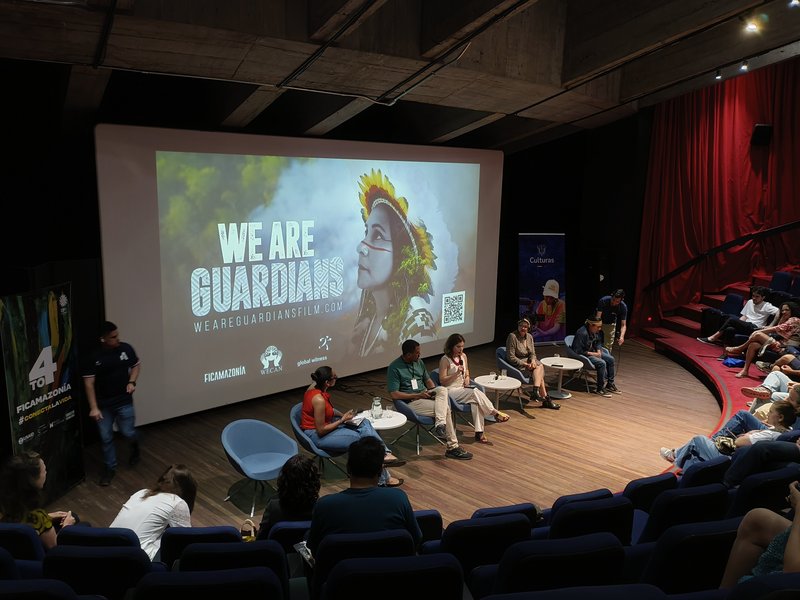
Indigenous leader Tye Parakanã speaks at a Global Witness screening of the documentary We are Guardians. His ancestral territory, Apyterewa, in northern Brazil’s Pará state has seen more deforestation than any other Indigenous territory in recent years in the Brazilian Amazon. Molly Robson / Global Witness
A similar insight was heard from Deyanira Soscue, exiting authority of the Cerro Tijeras Indigenous reserve in Colombia, at another panel.
“The extractive economic system tells us that it will bring us development, but we have never seen that development. What we have seen are threats, violence, massacres and displacement.”
Global financial systems perpetuate biodiversity loss – we need better rules to ensure that they don’t
Another big issue on the table was the need to align financial flows with the preservation of nature. As it stands, the global financial system is a major driver of biodiversity loss.
In a fascinating panel organised by the Forests and Finance coalition, experts shed light on the harsh choices facing lower-income and climate-vulnerable countries.

Shona Hawkes of the Rainforest Action Network told the audience that lack of accountability in the global financial system means that banks and financial institutions can make money off deals that cause environmental harm, but are rarely held accountable for due diligence failures. Molly Robson / Global Witness
Trapped by the current international financial system, low-income nations must often choose between economic gains and protecting their ecosystems.
Many international financial institutions mandate austerity measures that fuel extractive industries, so it’s no surprise that participating in an IMF loan agreement is linked to a staggering 9.2% increase in deforestation.
These financial structures exist outside UN oversight – rules that should protect biodiversity are instead seemingly greasing the wheels for its destruction.
This exploitative financial model isn’t just a modern-day issue – it’s another echo of colonial legacies that drained resources from subjugated countries to benefit wealthier nations.
COP16’s “finance day” spotlighted the Global Biodiversity Framework Fund, supposedly a lifeline for conservation efforts, which is intended to close the biodiversity funding gap.
But pledges to the fund fell embarrassingly short, with just USD $163 million promised by just over a handful of countries and one sub-national government – barely scratching the surface of the targeted $200 billion a year by 2030.
High income countries, who were supposed to contribute the largest sum, largely ignored the UN Secretary-General’s urgent call for contributions, redirecting their focus towards conversations about private sector funding to plug the gap.
The shortfall prompted a group of ministers from 20 African, Southeast Asian and Pacific nations to write a joint letter urging wealthier countries to urgently deliver the needed international funding for biodiversity.
What does this outcome mean? Climate-vulnerable countries saddled with debt will likely be further incentivised to continue resource exploitation for their economic survival, leading to further deforestation, biodiversity loss and a grim uptick in violence against land and environmental defenders.
Today’s financial rules may wear a new face, but they’re still forcing indebted countries to sacrifice their natural wealth to survive economically, while richer countries reap the rewards.
Speaker after speaker stressed the same point: these financial inequities are more than policy failures – they are holding the world back from genuine progress on biodiversity.
The subdued response from rich countries was not only disappointing; it also represented a significant moral shortfall.
Governments can still change this – but only if they act now.

A "Jenga" sculpture of biodiversity in the blue zone of COP16. Molly Robson / Global Witness
Things are moving, but not fast enough
The urgency at COP16 was palpable.
While vibrant art murals of toucans, jaguars, and sloths lined the streets of the environment summit, the grimmer reality is that Latin America and the Caribbean, home to some of the planet’s richest ecosystems, has witnessed a 95% decline in wildlife populations since 1970.
Currently, the Amazon is suffering its worst drought in over half a centuryn over a decade, compounded by wildfires that threaten this critical ecosystem.
And as the conference drew to a close, Spain was struck by devastating flash floods that claimed more than 200 lives, with harrowing images of cars stacked like toys in narrow streets rapidly going viral.
Apocalyptic news like this is becoming distressingly commonplace. As Jonathan Watts from The Guardian observes, “We are living in a time of unwelcome climate superlatives.”
Scientific reports reflect the devastation on our newsfeeds. Recently, the International Union for Conservation of Nature (IUCN) reported that 38% of the world’s tree species are at risk of extinction.
Alarmingly, to date, the world has yet to meet a single global target on halting the destruction of wildlife and ecosystems, as set out in 2010’s Aichi Targets.
Action at COP16 continued at a glacial trajectory, failing to meet the urgency of these developments.
The financial commitments made at COP16 fell drastically short of what is needed to protect ecosystems.
And by the close of the conference, governments had still failed to reach consensus on key issues, including frameworks for monitoring key biodiversity targets.
Without urgent action, we may not be able to rely on nature’s ability to absorb carbon and regulate the climate any longer.
What can we do?
In the face of these challenges, resistance emerged as both a tool and an opportunity. Stories of resilience from defenders the face of unrelenting attacks on their safety, health and territory were consistently humbling.
"Colombia is a school of human rights; it is a school of activism," remarked the UN Human Rights representative in Colombia, Juliette de Rivero, on the resilience of Colombian defenders and local communities who continue their fight in one of the world's most perilous environments for environmental activism.
In the face of this hostility, their steadfast commitment to their homes, lands and communities shows us the meaning of integrity and courage. As tremors from our uncertain present and future begin to shake us, there is much we can learn from them.
But these communities shouldn't have to be so resilient. Their struggles are bitterly unjust and entirely avoidable. It is up to powerholders and leaders of wealthy nations to exhibit a fraction of the same bravery.
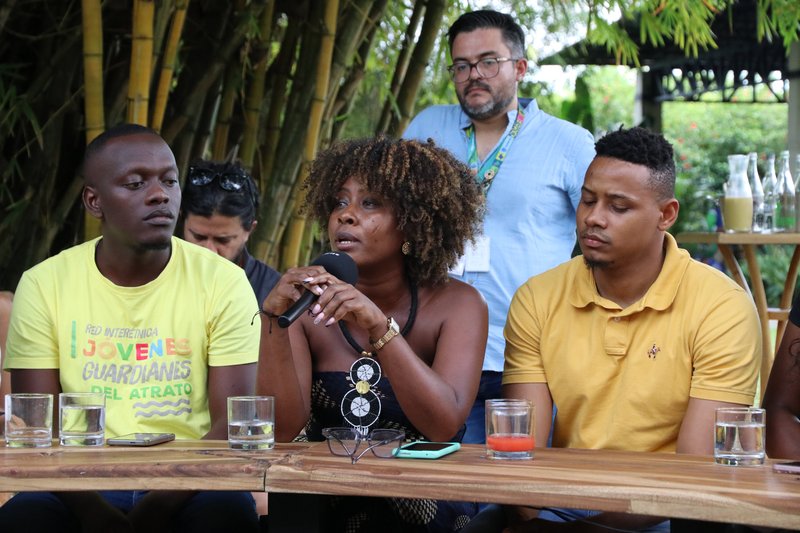
At a Global Witness event in partnership with Earthrise, defenders of Colombia’s Atrato River discuss the threats facing environmental defenders and the lessons the world can learn from the Guardians of the Atrato. Molly Robson / Global Witness
Unravelling the systems that fuel this violence against the land and its people begins with first recognising our essential interconnectedness.
At the heart of many Indigenous and traditional knowledge systems is the concept of holistic stewardship – caring for the environment in ways that sustains all life, not just human needs.
As Afro-Colombian defenders of the Atratro river express it: “All for the life of all.”
This philosophy extends beyond local stewardship solutions to global approaches to climate action. Why, for example, do high-level discussions treat the climate crisis as separate from nature loss?
The critical emergencies of our time – ecocide, genocide, femicide – demand holistic solutions. Attempting to solve them in siloes is like bailing out a sinking ship one compartment at a time.
Susana Muhamad, Colombia’s Environment Minister and president of COP16, echoed this sentiment, warning that tackling biodiversity loss separately from climate action is not only insufficient but dangerous.
Current approaches that focus solely on decarbonisation, such as transitioning to renewable energy, ignore the broader nature crisis and place the rights of defenders at greater risk.
“Climate and biodiversity are two sides of the same coin,” Muhamad stressed.
For the world to meet the KMGBF targets, the financial system must be strongly regulated, strong laws must protect defenders, and the global community must recognise that all these crises are powerfully connected – and act accordingly.
Our prevailing systems – social, financial, geopolitical, environmental – are infected with injustice. These twinned crises are merely different symptoms of the same decay.
There is no time left to waste – nature is calling on us to act now.
As President Petro warned, the era of human extinction has already begun. Whether we heed these warnings will determine the future of life on Earth. May we find the collective courage to rise to the challenge.
